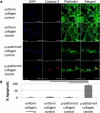Live free or die: stretch-induced apoptosis occurs when adaptive reorientation of annulus fibrosus cells is restricted
- PMID: 22516752
- PMCID: PMC3348381
- DOI: 10.1016/j.bbrc.2012.04.018
Live free or die: stretch-induced apoptosis occurs when adaptive reorientation of annulus fibrosus cells is restricted
Abstract
High matrix strains in the intervertebral disc occur during physiological motions and are amplified around structural defects in the annulus fibrosus (AF). It remains unknown if large matrix strains in the human AF result in localized cell death. This study investigated strain amplitudes and substrate conditions where AF cells were vulnerable to stretch-induced apoptosis. Human degenerated AF cells were subjected to 1 Hz-cyclic tensile strains for 24h on uniformly collagen coated substrates and on substrates with 40 μm stripes of collagen that restricted cellular reorientation. AF cells were capable of responding to stretch (stress fibers and focal adhesions aligned perpendicular to the direction of stretch), but were vulnerable to stretch-induced apoptosis when cytoskeletal reorientation was restricted, as could occur in degenerated states due to fibrosis and crosslink accumulation and at areas where high strains occur (around structural defects, delaminations, and herniations).
Copyright © 2012 Elsevier Inc. All rights reserved.
Figures



References
-
- Bibby SR, Jones DA, Ripley RM, Urban JP. Metabolism of the intervertebral disc: effects of low levels of oxygen, glucose, and pH on rates of energy metabolism of bovine nucleus pulposus cells. Spine (Phila Pa 1976) 2005;30:487–496. - PubMed
-
- Roughley PJ. Biology of intervertebral disc aging and degeneration: involvement of the extracellular matrix. Spine (Phila Pa 1976) 2004;29:2691–2699. - PubMed
-
- Adams MA, Roughley PJ. What is intervertebral disc degeneration, and what causes it? Spine (Phila Pa 1976) 2006;31:2151–2161. - PubMed
Publication types
MeSH terms
Grants and funding
LinkOut - more resources
Full Text Sources

